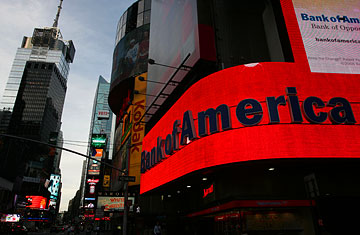
A Bank of America branch in New York City
(2 of 2)
Instead, a number of economists like the idea forming a bad bank to buy up assets tied to defaulting mortgage loans and other troubled debts. This is similar to Paulson's original idea for TARP. As those bonds fall in value, the banks have to take losses and write off capital, putting them closer to insolvency. If the government were to take the bonds off the banks' hands at their current price, that would stop the bleeding. Rod Dubitsky, who follows bonds backed by consumer loans at Credit Suisse First Boston, says buying up mortgage loans would greatly increase the capital of the banks. That's because the government purchases would probably push up the value of all bonds and improve the capital position of all banks, not just the ones lucky enough to offload their troubled assets onto the government.
The problem with this is, it's hard to know what to pay for the bonds. Pay too little and the banks will go out of business, because they will have to realize huge losses on the sales, wiping out their capital. Pay too much and the government ends up taking a big hit on worthless bonds. The one good thing with the preferred-share plan is that if the banks recover, taxpayers get their money back and the government might even see some upside in the shares. Not the case when you just buy the bonds. In that scenario, the banks improve, but the taxpayers take the full hit for the bad loans the banks made in years past. Few voters would likely enjoy that plan. So politicians are not going to be quick to embrace it.
Nouriel Roubini, the New York University economist who said early on that problems in the housing market could lead to a financial crisis, argues that both the bad-bank plan and the capital-repurchase plan need to be done at the same time. He suggests the government pay the low market price for the troubled bonds and then immediately inject capital into the banks. With the bad bonds off the bank's balance sheets, you would know exactly how much capital they needed to replace. What's more, the government would be buying shares in the banks at the low price, rather than shoving money in as they continue to go down. (See the top 10 financial collapses of 2008.)
The problem with this plan is that it would be very expensive, at least at first. Roubini estimates that U.S. banks need a total of $1.4 trillion in new investments to keep them afloat. Geithner probably doesn't want to be the person going to Congress to ask for that check.
Lastly, some people think the best solution would be to simply change the accounting rules. Congress would have to do it, but it might be an easy sell because it doesn't cost any money upfront. Many people argue that the that value of mortgage bonds, many of which plummeted in 2008, are reflective of a fear that many borrowers will not repay their home loans, not actual losses already taken. The nation's foreclosure rate, while up significantly, is still well under 5% for all mortgages.
So forget the rule that banks have to mark the bonds and other tradable loans on their books to market prices, which for the past year has been causing huge losses due the writedowns. Hedge-fund manager James Ellman of Seacliff Capital thinks removing the mark-to-market rule would give an immediate boost to the banks and to the economy as well. He predicts that shares of the banks would soar on the news, boosting the S&P 500 and repairing the damage done to millions of investors' 401(k) plans. It would probably help the positions of a number of investors like Ellman, who buys bank stocks, as well.
A number of accounting firms contend that allowing the banks to name their price for the assets on their books, rather than relying on the market, could undermine investor confidence in the banks. Who would trust a company that uses mark-to-make-believe accounting? Change the rule, they say, and banks stock could plummet anyway, just for a different reason.
There are the choices: nationalization; a bad bank; an accounting fix. Tim, for all of our sakes, please choose wisely.
